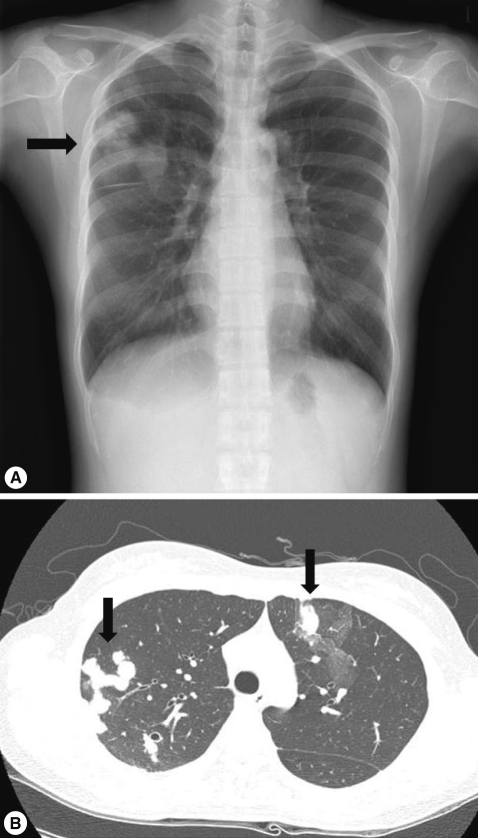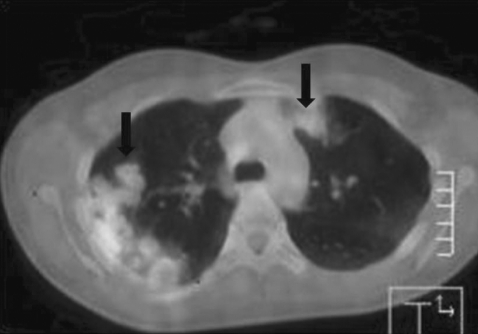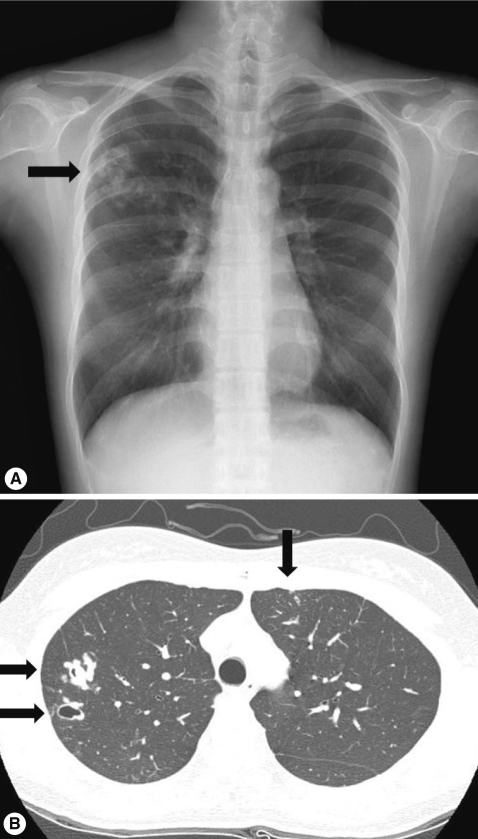A Pulmonary Paragonimiasis Case Mimicking Metastatic Pulmonary Tumor
Article information
Abstract
Pulmonary paragonimiasis is a relatively rare cause of lung disease revealing a wide variety of radiologic findings, such as air-space consolidation, nodules, and cysts. We describe here a case of pulmonary paragonimiasis in a 27-year-old woman who presented with a 2-month history of cough and sputum. Based on chest computed tomography (CT) scans and fluorodeoxyglucose positron emission tomography (FDG-PET) findings, the patient was suspected to have a metastatic lung tumor. However, she was diagnosed as having Paragonimus westermani infection by an immunoserological examination using ELISA. Follow-up chest X-ray and CT scans after chemotherapy with praziquantel showed an obvious improvement. There have been several reported cases of pulmonary paragonimiasis mimicking lung tumors on FDG-PET. However, all of them were suspected as primary lung tumors. To our knowledge, this patient represents the first case of paragonimiasis mimicking metastatic lung disease on FDG-PET CT imaging.
INTRODUCTION
Paragonimiasis is a zoonotic disease caused by the trematode Paragonimus spp. About 48 species of Paragonimus have been described; however, only 16 of these infect humans. Paragonimus wetermani is the most common species infecting humans, causing pulmonary and pleural inflammation through ingestion of raw freshwater crabs or crayfish infected with the metacercariae, the infective stage of this parasite [1]. However, patients diagnosed with paragonimiasis occasionally report that they had never eaten freshwater crabs or crayfish. There is a possibility that they ate food contaminated with metacercariae from the fingers or cooking utensils of people who recently handled these crustaceans [2].
Patients with paragonimiasis reveal a wide variety of radiographic and CT findings, including pulmonary nodules or masses, and sometimes they are suspected to have a lung tumor [3]. FDG(fluorodeoxyglucose)-PET (positron emission tomography) is used recently to differentiate benign from malignant lesions, and it has been shown to be more effective than CT [4]. However, FDG is not a cancer-specific agent, and false positive findings in benign diseases, including paragonimiasis, have been reported [5-9]. Unlike those cases mimicking primary lung tumors, we report a case of pulmonary paragonimiasis with false-positive FDG-PET mimicking a metastatic lung tumor.
CASE REPORT
A 27-year-old woman was admitted to a local hospital with productive cough and blood-tinged sputum. Chest X-ray showed multiple nodules and she received anti-tuberculosis chemotherapy for 2 months. A follow-up chest X-ray taken 2 months later revealed an increased size of the nodules, and the patient was referred to our hospital. She had no history of ingestion of freshwater crabs, crayfish, or wild pig meats. On admission, she was in good general health, and the physical examination was normal. A complete blood cell count (CBC) revealed WBC levels of 11,670/mm3, hemoglobin levels of 12.6 g/dL, platelet levels of 244,000/mm3, absolute eosinophil count (AEC) of 6,185/mm3. Serum tumor markers showed a high CA 125 level of 47.6 U/ml (normal <35 U/ml). Other laboratory tests revealed no abnormal findings. A chest X-ray showed multiple mass-like opacities in the right lung (Fig. 1A). Chest CT revealed multiple nodules with adjacent areas of ground-glass opacity (GGO), which corresponded to hemorrhagic infarcts as in a case of hemorrhagic metastasis or other benign conditions (Fig. 1B). FDG-PET CT was performed to find out a possible primary site of malignancy. However, it revealed no remarkable abnormal finding except an increased FDG uptake (max SUV: 3.1) in the lung lesions (Fig. 2). Bronchoscopic and cytological examination of the sputum showed nothing of particular significance. We could not observe parasite eggs in stool, sputum, or bronchoalvelolar lavage (BAL) fluid. However, ELISA (Genedia Ab ELISA, Green Cross MS, Yongin, Korea) was positive for antibodies against P. westermani. She received praziquantel therapy (25 mg/kg, 3 times a day for 2 days). At a week after the medication, the patient's eosinophil count decreased from 6,185/mm3 to 2,468/mm3. A follow-up chest X-ray at 4 months after the treatment showed interval decrease in the size of multiple nodules in the right lung and CT at 6 months after the treatment revealed markedly diminished nodules in size with cystic changes (Fig. 3).

Chest X-ray and computed tomography (CT) on admission. (A) Multiple mass-like opacities are shown in the right lung (arrow). (B) Multiple nodules with adjacent areas of GGO, suggestive of hemorrhagic metastasis are observed in both lungs (arrows).
DISCUSSION
Paragonimiasis is a food-borne parasitic disease caused by the trematode P. wertermani, which is endemic in East Asia [1]. Adult P. westermani worms are bean-shaped, 5-12 mm long, 3-6 mm wide, and 2-5 mm thick, a size that can be seen on radiologic images. Several studies reported that the common radiologic findings of pleuropulmonary paragonimiasis included pleural effusion, hydropneumothorax, pulmonary nodules, or air-space consolidation, and cysts [10]. A report by Kim et al. [11] suggested that the main CT feature of pleuropulmonary paragonimiasis in 31 patients was pulmonary nodules, including multiple nodules in 7 patients (23%) as in our patient. In the present case, areas of surrounding GGO were observed around the nodules, which suggest hemorrhage. It led us to consider the findings as hemorrhagic metastasis, though these finding are also shown in a number of benign conditions, such as angioinvasive aspergillosis and paragonimiasis [12]. Abnormally increased FDG uptake (max SUV: 3.1) in the lung lesions on FDG-PET CT supported a possibility of malignancy further.
FDG-PFT is a highly accurate imaging in evaluating pulmonary lesions, taking advantage of the higher metabolic rate of tumor cells to show increased accumulation of FDG in malignant lesions. However, an increased metabolic rate is also observed in inflammation [13,14]. Many reports have demonstrated increased FDG uptake in inflammatory, granulomatous, and infectious lung diseases, including bacterial, mycobacterial, fungal, and parasitic infections.
Several cases of pulmonary paragonimiasis were reported that showed a high uptake suggestive of a malignancy on FDG-PET CT images [5-9]. All of them were suspected as primary lung cancers and confirmed as paragonimiasis by detecting eggs in the tissue obtained from biopsy or operation. Although the definite causes of FDG accumulation have not yet been proven in paragonimiasis, it seems likely that inflammatory cells, including eosinophilic infiltration, active inflammatory responses, and viable worms, cause a high FDG uptake [4].
The diagnosis of paragonimiasis can be made by detecting eggs in the tissue section, or more commonly, in the stool, sputum, or BAL fluid, or by a positive anti-Paragonimus antibody test. However, egg detection rates have been reported to be low (28-38%) and eggs are not present in the sputum until 2-3 months after an infection. Serum determination of antibodies to Paragonimus is more accurate in early infections, and ELISA is highly sensitive (92%) and specific [15]. In our case, Paragonimus eggs were not found in the stool, sputum, and BAL fluid. Instead, the patient's serum strongly reacted to P. wertermani antigen in ELISA.
Considering lung nodular lesions with GGO on chest X-ray and CT, in combination with ELISA test for paragonimiasis, FDG-PET itself was an unnecessary examination to diagnose paragonimiasis in our patient. In addition, nodular lesions were continuing to the visceral pleura, which is rather unusual for metastatic lung cancers. On the other hand, Paragonimus invades from the pleural cavity to the lung parenchyma so that continuous lesions from the pleura to the nodular lesion in the lung parenchyma are a typical feature of radiological finding in paragonimiasis. Nevertheless, FDG-PET was performed to exclude the possibility of malignancy owing to the elevated serum level of CA 125. The serum CA 125 is often increased in patients with malignancy, such as ovarian cancer, endometrial cancer, and pancreatic cancer. However, it is also increased in a variety of benign conditions, including endometriosis, uterine fibroids, pelvic inflammatory disease, heart failure, liver and renal disease, as well as in approximately 1 percent of healthy women [16]. There has been no report of paragonimiasis patients showing high level of CA 125.
As a possibility in the differential diagnosis of multiple pulmonary nodules or masses with FDG-PET positive finding, especially in endemic regions with a high prevalence of food-borne parasitic diseases, paragonimiasis should be considered.

